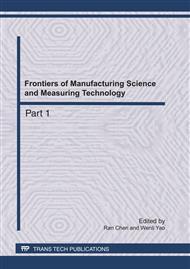p.582
p.587
p.592
p.596
p.600
p.605
p.610
p.616
p.620
Research on Quality Control of Electronics Products Based on Signal Game Model in the Supply Chain under Asymmetric Information
Abstract:
Various participants in the supply chain must combine their own quality control and the relevant coordination decision-making with other enterprises to ensure they have strong competition position in the supply chain. Transactions among the manufacturers and retailers with the existence of asymmetric information in the electronic production system, as a result, the game will existent among them. In this paper, application of signal game theory to quality control of retailers are studied and the signaling game model of equilibrium to satisfy the three conditions are also be analysis.
Info:
Periodical:
Pages:
600-604
Citation:
Online since:
May 2011
Authors:
Price:
Сopyright:
© 2011 Trans Tech Publications Ltd. All Rights Reserved
Share:
Citation:


